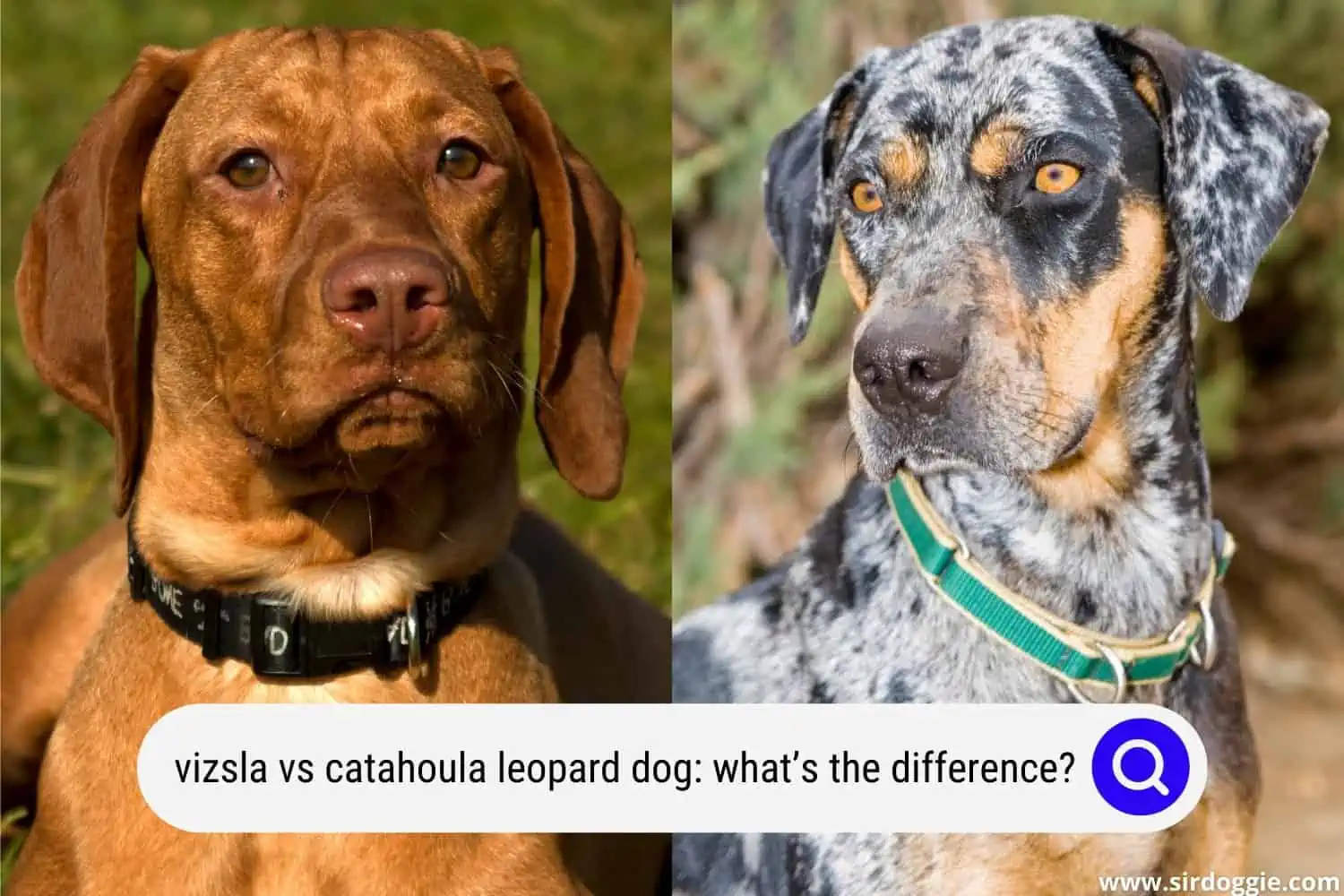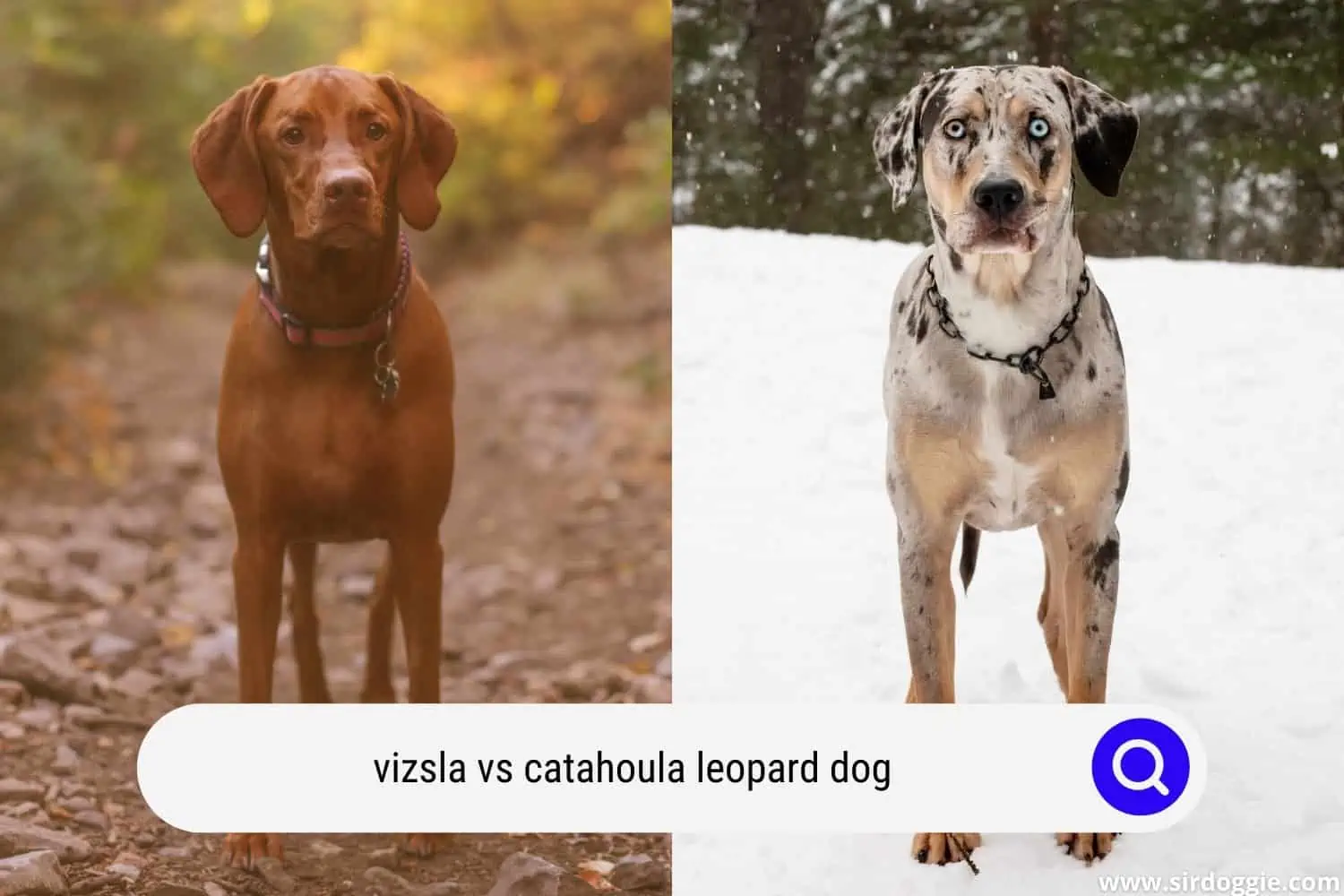Vizsla vs Catahoula Leopard Dog: What’s the Difference?
The Vizsla is an active dog that demands a high level of physical activity, mainly taking into account its history as a hunting dog. However, the Catahoula Leopard Dog is an agile and athletic dog that is quite protective of the property and home of its owner. However, the two dogs are often sought after by those willing to adopt or purchase.
So, what are the differences between the two, and which one is the better breed to buy? In this Vizsla vs Catahoula Leopard Dog comparison article, we’ll see how both breeds differ.

The Vizsla Dog
Vizsla History
As one of its names indicates, the animal is originally from Hungary. According to engravings created in the 10th century, the dog was used by Barbarian Magyar tribes that plundered different parts of central Europe, in the so-called Dark Ages.
In modern times, the Vizsla dog breed has gone through its standardization process. As a result of the process of improving these standards, the Vizsla was recognized by the International Cynological Federation in 1936.
One of the most challenging moments in the history of this dog is the period when the breed was almost extinct, during the First World War. However, connoisseurs of the animal preserved some puppies and kept the breed safe.
Also, something very similar happened again in 1945 in Hungary. Many Hungarians took their Vizslas with them during the regime’s flight. The dog did not reappear until the 1950s, and the breed was recognized by the American Kennel Club in the year 1960.
Vizsla Physical characteristics
The Vizsla is medium in size. The height of the males of the breed varies between 55 and 60 centimeters, while the females are slightly smaller, with 53 to 58 centimeters in height. In both sexes, the animal’s body is muscular and of good proportions.
The ears are long and silky and fall around the head. An incredible feature of this dog is that its eyes have the same color as its coat.
Vizsla Character
Several traits characterize the Vizsla in personality. The pet is active, and demands a high level of physical activity, mainly taking into account its history as a hunting dog.
Another striking feature is the strong attachment to the human family. It is a mascot that prefers to be always accompanied by its tutor, master, or another member of the house. Also, the breed is super smart, so it needs to be encouraged to exercise regularly to avoid destructive behaviors.
Having a puppy of this breed will brighten the days at your home. That’s because it is an animal that likes to interact with people. It tolerates other dogs and kittens in the same environment well, as long as they are socialized from puppies.
It’s also friendly with children and strangers. In any case, the owner must supervise interactions with the animal. It is not a dog that barks excessively and should not be left alone for long periods.
Vizsla Health, hygiene, and wellness
You can see that the Vizsla dog has a beautiful coat, right? However, to keep the pet’s rust-red hair, it is essential to take certain precautions. These are simple routines, but they make a big difference in the pet’s quality of life.
It undergoes some periods of hair loss, so the owner must maintain a weekly brushing routine. Use a comb or brush with rubber bristles for the ideal result!
Because it is an energetic dog with a routine full of activities, the pet will need regular baths. The emphasis on this care is even greater in situations where the animal is especially dirty, such as playing on the ground.
For this care, remember to always use products suitable for the type of coat of the pet. A recommendation is that the bath should be done with warm water and an appropriate soap or shampoo. Don’t forget to rinse and dry the fur very well.
In general, the dog is very healthy. However, like any breed of dog, it may be predisposed to certain problems, such as cancer. For this and other reasons, breeder clubs recommend hip, thyroid, and eye examinations.
To avoid any such situation, take the pet to the veterinarian regularly. Thus, the specialist can have early diagnoses of possible diseases, in addition to giving tips to keep the pet always healthy.
The Catahoula Leopard Dog
Catahoula Leopard Dog Origin and History
Considered one of the rarest in the world, this breed appeared in Louisiana, in the United States. It can be said that since the late 1970s, the breed has become quite revered in Louisiana, being one of the great symbols of local culture.
Even there, the dog has been known since that time as Louisiana Catahoula Leopard Dog, or simply, Louisiana. It’s also called the Leopard Dog of the Catahoula.
In the 17th and 15th centuries, with the arrival of colonizers in the region, the breed would have been used for practices such as hunting wild boar and herding activities, one of the local traditions.
Over time, this dog has become an important character for the American state. As for its origin and history, some studies point out that the Catahoula dog would have genetic links with dogs of natives of the Americas, well before the arrival of the Europeans.
The breed would have been domesticated by the North American Indian people. They may have been crossed with European breeds brought by the colonizers too.
Catahoula Leopard Dog Character
These dogs can be active in field activities and are very adept at handling wild cattle in remote locations. The Catahoula Leopard Dog is agile, athletic, and is quite protective of the property and home of its owner.
They are kind, faithful, intelligent, and very independent. Michele Welton, a specialist in canine breeds, mentions in an article for the website YourPurebredPuppy that to stimulate the best temperament of the animal, it must be frequently exercised, as it is very active and it needs to “spend all its battery” power.
And as for the presence of strangers, the Leopard Dog of the Catahoula tends to be indifferent, but very protective in relation to its owner. In any case, the Catahoula Pup must be socialized as soon as possible. Michele Welton also points out that as dogs of this breed tend to be independent, the owner also needs to show confidence.
As for the physical aspects, it is a muscular and medium to large-sized dog, which will always be willing to do its job (hunting, grazing, helping with cattle management, as a guard dog, etc.). The dog has dense and firm fur and it’s found in colors from brown to gray, among others.
Catahoula Leopard Dog Care
As mentioned before, Catahoula Cur dogs really like and appreciate physical activities, because they already have an instinct for work and hunting. So, in this way, in relation to basic care, it will be necessary that these animals have space to run and sniff. The ideal, in a way, is that they are living on farms.
When they remain sedentary and confined to places with little space, these muscular animals can become sad and even difficult to deal with. When bored, they can wreak havoc on the home and have difficulties with relationships with other animals. Thus, socialization, as previously mentioned, is important.
Socialization basically consists of introducing them to the outside world, facilitating their coexistence in front of other people and animals. For this reason, it is always pertinent to remember: do not hesitate to take them on long walks through parks and other free areas, together with other people.
Catahoula Leopard Dog Health
The most common health problems for Catahoula dogs are related to complications in the hip region. It is also possible that it develops diseases in vision and deafness. They often have infections in the skin, when there is no proper hygiene care.
Thus, it is essential to consult the clinic for pets frequently, as a means of prevention or when it is necessary to carry out a specific treatment or examination. In any case, it is a very healthy breed, but these health complications tend to arise as the pet ages.
As for life expectancy, the Catahoula Leopard Dog can live, on average, for 14 years. However, like many other canine breeds, depending on the animal’s daily life and health history, it is possible that it can live up to 18 or 20 years.
Comparison table: Catahoula Leopard Dog vs Vizsla
| Character/characteristics | Vizsla | Catahoula Leopard Dog |
| Type of breed | Purebred | Purebred |
| Country of origin | Hungary | United States |
| Price | $800 – 1200 | $300 – 500 |
| Dog size | Large | Large medium |
| Coat | Fine, Short, Dense, Hard, Coarse, No Undercoat | Smooth |
| Grooming needs | Minimal | Minimal |
| Hair shedding | Moderate | Low shedders |
| Prey drive | Low drive to chase and catch animals | Little impulse to chasing animals |
| Intelligence | Very intelligent | Average intelligence level |
| Friendliness | Stranger and kids friendly, a bit friendly to cats and other pets, not office and elderly-friendly | Stranger and kids friendly, not apartment-friendly, friendly to cats, other dogs, and pets, not office and elderly-friendly |
| Trainability | Quite easy to train | Easy to train |
| Expectancy | 10 – 14 years | 11 to 14 years |
| Needs for exercise | Requires a lot | Requires a lot |
| Drooling | Minimal | Minimal |

Conclusion
Also called the Hungarian Pointer, the Vizsla is described by tutors and specialists as an intelligent, docile, and playful dog. Our medium-sized friend is a natural lover of physical activities and has a beautiful red coat.
Very interactive, it easily clings to its adoptive family. Always energetic, the Vizsla was widely used as a hunting dog, and today, it can work in both guard and sports functions.
The Catahoula dog on the other hand is rarer than the Vizsla and widely sought after. It’s also an agile and athletic dog and is quite protective of the property and home of its owner. It’s not for hunting but is stranger and pet-friendly at home.

Family Dog Expert Author
Hi there! I’m Stuart, a devoted dog lover and family dog expert with over a decade of experience working with our furry companions. My passion for dogs drives me to share my knowledge and expertise, helping families build strong, loving bonds with their four-legged friends. When I’m not writing for SirDoggie, you’ll find me hiking, playing with my beautiful dog, or studying music.